Profile of Reading
Reading is the principal regional and commercial centre of the Thames Valley, a major retail and leisure destination, with a thriving night-time economy.
There has been a huge shift in the town’s economy, from its origins in ‘beer, biscuits and bulbs’ to a compact service economy which specialises in business and insurance services, and has some of the finest high-tech business parks in the South East, with many international companies such as Microsoft and Oracle choosing Reading as their home.
The town is a major transport interchange, continuing to benefit from its strategic location on the M4 corridor and proximity to Heathrow Airport and London. Reading is also home to the University of Reading and Reading College, with a large percentage of the local working population highly skilled.
However, prosperity has brought its own problems, with pressure on infrastructure, communities and the environment. The high cost of living and, in particular, the high cost of housing, have had a significant impact on local communities. Although Reading can undoubtedly demonstrate success and wealth, the town also contains wards amongst some of the most deprived in the country.
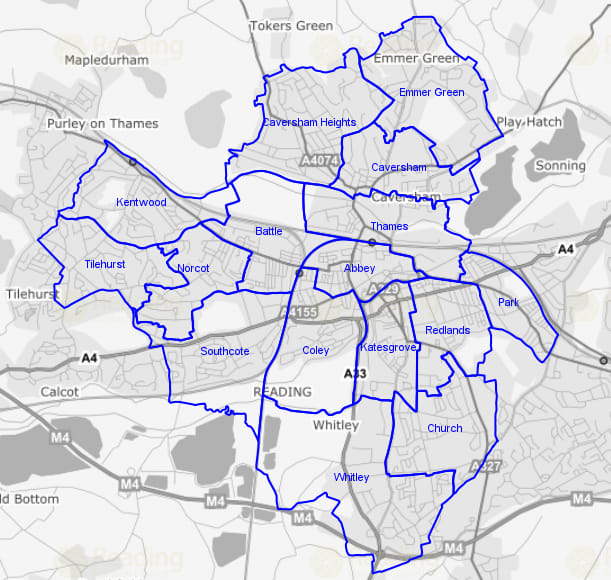
Population and households
Currently 178,196 residents1 67,700 households2) are estimated to live within the Reading borough boundary, while around 233,000 people live in Reading’s greater urban area3. The population increased by 11.9% between 2021 and 2011, while the number of households rose by 7.6%4. Reading has a generally younger population, however the proportion of older people aged 65+ increased by 17.2% between 2011 and 20215.
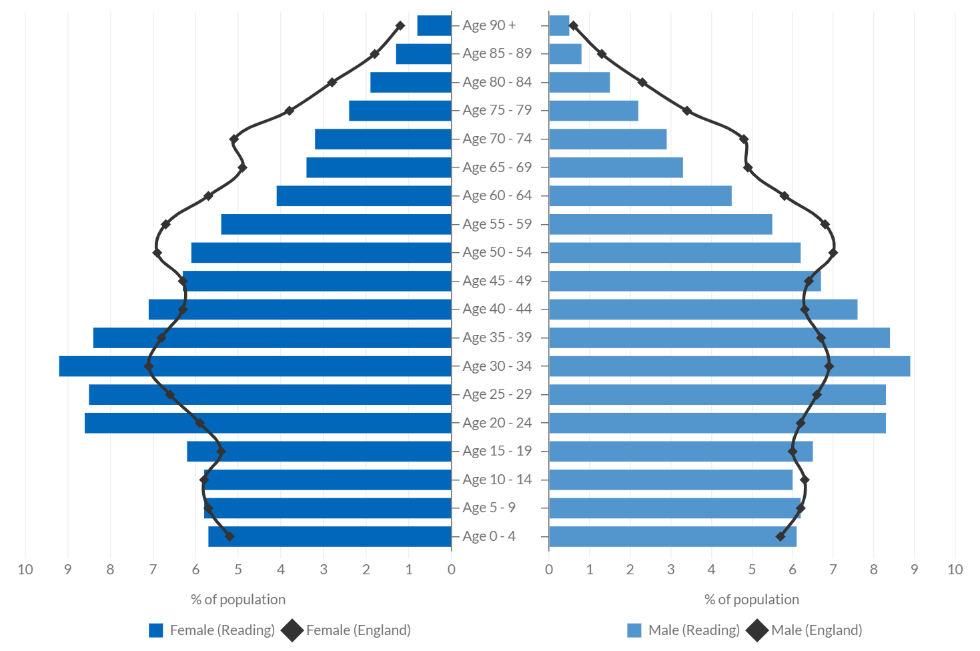
Population estimates and projections
| Age | 2023 | % of total 2023 | 2011 |
|---|---|---|---|
| 0-4 | 10,464 | 5.9% | 7.7% |
| 5-9 | 10,700 | 6% | 5.5% |
| 10-19 | 21,958 | 12.3% | 11.4% |
| 20-39 | 60,067 | 33.7% | 36.7% |
| 40-59 | 45,313 | 25.4% | 23.2% |
| 60-79 | 23,690 | 13.3% | 12.1% |
| 80+ | 6,004 | 3.4% | 3.5% |
| Total | 178,196 | N/A | N/A |
Household composition
| Household composition | Reading 2021 | England 2021 | Reading 2011 |
|---|---|---|---|
| One person | 28.5% | 30.1% | 30.6% |
| With pensioner/s | 14.6% | 22% | 14.7% |
| Couple with no children | 16.8% | 16.7% | 17.3% |
| Couple with dependent children | 20% | 18.9% | 19.3% |
| Children with non-dependent children | 5.3% | 6.3% | 4.6% |
| Lone parent | 10.9% | 11.1% | 10.8% |
Sources: 2021/2011 Census. ONS
1ONS mid year estimates for 2023
2ONS Census 2021
3Local Transport Plan 2011-2026
4ONS Census
5ONS Census
Ethnicity
Reading has a very diverse population, with 46.5% now belonging to a Black and Minority Ethnic community (including white and other communities), the joint second highest proportion in the South East after Slough and with Oxford (2021 Census, Office for National Statistics), and up from 35% in 2011.
All ethnic groups have increased since 2011 apart from British, Irish and Black Caribbean. There has been a significant increase in the number of Romanian speakers since 2011.
| Ethnicity | Reading 2021 | England 2021 | Reading 2011 |
|---|---|---|---|
| White British | 53.5% | 73.5% | 65.3% |
| Other White | 13.7% | 7.5% | 9.5% |
| Mixed | 5.1% | 3% | 4% |
| Indian | 6.2% | 3.3% | 4.2% |
| Pakistani | 4.8% | 2.8% | 4.5% |
| Other Asian | 6.7% | 3.5% | 4.9% |
| Black Caribbean | 1.9% | 1.1% | 2.1% |
| Black African | 4.4% | 2.6% | 3.9% |
| Black other | 4.5% | 2.9% | 4.5% |
| Chinese | 1.5% | 0.8% | 1% |
| Other ethnic group | 2.8% | 2.2% | 1% |
Source: 2021 Census, Office for National Statistics
Language
| Language | Count 2021 | Count 2011 |
|---|---|---|
| English | 136436 | 126,690 |
| Polish | 4154 | 3,768 |
| Nepalese | 4147 | 2,430 |
| Romanian | 2642 | 194 |
| Urdu | 1520 | 1,790 |
| Portuguese | 1512 | 655 |
| Spanish | 1264 | 585 |
| Italian | 1024 | 450 |
| Arabic | 985 | 600 |
| Panjabi | 968 | 921 |
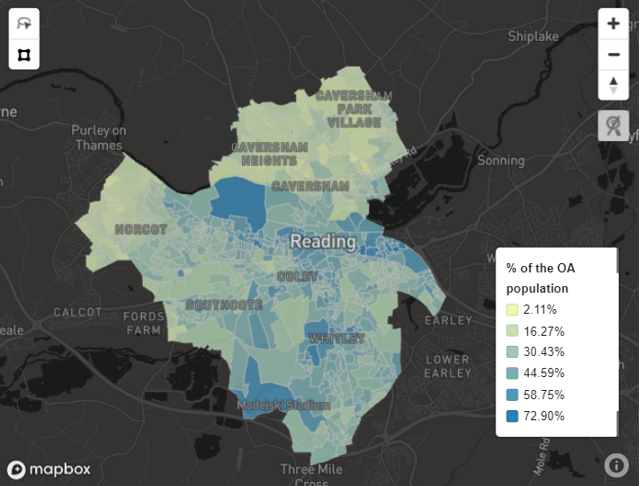
Economy, employment and skills
Over the last 20 years, Reading has developed from an economy based on trading and manufacturing into a centre for leading edge information communication technology (ICT) companies and is now one of the largest insurance and business service centres in the country. Reading is now a major retail centre, with a significant evening economy.
Pre-COVID, unemployment was low, and although it is now higher, it is still just below the national average. Reading has a highly skilled workforce, with more jobs than workers, however there is a disparity in terms of skills and earnings between the workforce and Reading residents, with in-work poverty increasing for residents.
Reading’s occupation profile has changed since 2011 census, with professional and managerial occupation types showing the most significant increase. Some service and elementary occupations have increased and administrative occupations decreased.
- Reading appears in the top 5 UK cities for good economic growth (DEMOS-PWC Good Growth for Cities Index) and in the top 10 for business numbers, private sector jobs, GVA and qualifications (proportion of working age population claiming JSA or Universal Credit)
- Reading’s workforce ranks within the UK top 5 for qualification levels and productivity (Centre for Cities, 2020)
- The average (mean) gross annual salary (NOMIS; Annual Survey of Hours and Earnings – full time workers)for workers in Reading in 2023 was £44,719 for residents, higher than the national average but lower than the South-East average for residents, and £47,237 for workers, higher than both South-East and England.
- In terms of unemployment, the claimant count rate (proportion of working age population claiming JSA or Universal Credit) is currently 4.6% (Aug 24), compared with 3.2% for the South-East and 4.4% nationally (NOMIS). This is an increase on the Aug 2023 figure of 3.8%, and higher than the pre-covid position of 2.7% (Jan 2020).
Qualifications – updated summer 2023
| Highest level of qualification | Reading 2021 | England 2021 | Reading 2011 |
|---|---|---|---|
| No qualifications | 15.8% * | 18.1% | 17.4% |
| Level 1 qualifications | 9.1% | 9.7% | 12.2% |
| Level 2 qualifications | 10.7% | 13.3% | 12.3% |
| Apprenticeship | 4.1% | 5.3% | 2.5% |
| Level 3 qualifications | 16.8% | 16.9% | 13.4% |
| Level 4 qualifications and above | 40.4% | 33.9% | 34.8% |
| Other qualifications | 3% | 2.8% | 7.4% |
Source: 2021 Census, Office for National Statistics (% of residents aged 16-74)
Housing
Reading’s continued success has further increased demand for housing, resulting in higher than national average prices, with the median house price now around 3 times higher in 2023 than 2000 (ONS house price statistics for small areas, 1995 – 2020). Because of this, the property market has become increasingly inaccessible to those on low incomes, due to the shortage of affordable housing.
| Housing tenure | Reading 2021 | England 2021 | Reading 2011 |
|---|---|---|---|
| Owner occupied | 50.4% | 61.3% | 54.8% |
| Shared ownership | 1.3% | 1% | n/a |
| Social rented | 16.1% | 17.1% | 16.3% |
| Private rented | 31.9% | 20.5% | 26.1% |
| Rent free | 0.2% | 0.1% | n/a |
Source: 2012 Census, Office for National Statistics
| Location | Median house price | Median detached house price | Median semi-detached house price | Median terraced house price | Median flats/maisonette price |
|---|---|---|---|---|---|
| Reading | 350,000 | 696,757 | 464,765 | 356,364 | 241,424 |
| England | 290,000 | 554,793 | 333,749 | 316,656 | 317,057 |
Source: LG Inform Plus, 2023 Q1 (rolling)
Deprivation
Although the pace of change in Reading has been rapid, there is a clear mismatch between outstanding economic success and the level of benefits to local people, leaving a significant gap between Reading’s most and least prosperous neighbourhoods. Reading has, within a small geographic area, some of the most affluent and the most deprived neighbourhoods in the whole of the Thames Valley.
- Reading is the 3rd most unequal ‘city’ in terms of wealth (Centre for Cities, Gini co-efficient 2017)
- Reading is below the national level in terms of child poverty, with just over 1 in 6 children, or 15.6%, in relative poverty. This is a decrease on 17% in the previous year (DWP 2023), following a steady increase since 2015 (with the exception of a dip in 2020)
- According to the Index of Multiple Deprivation (2019), Reading as a whole is ranked the 141st (rank of average score) most deprived out of 317 local authorities in the country, compared with 142nd most deprived in 2015. There are 5 Lower Super Output Areas (LSOAs) in Reading within the most deprived 10% nationally, compared with 2 in 2015. Super Output Areas (SOAs) are a set of geographical areas developed following the 2001 census. Lower Layer Super Output Areas (LSOAs) typically contain 4 to 6 OAs with a population of around 1500
- In terms of the Census 2021 deprivation dimensions, Reading has a slightly higher % households deprived on all 4 dimensions (0.3%) than nationally (0.2%), but also a high % not deprived on any dimension (52% compared with 48% nationally). Fewer households are deprived than in 2011.
Index of Multiple Deprivation 2019
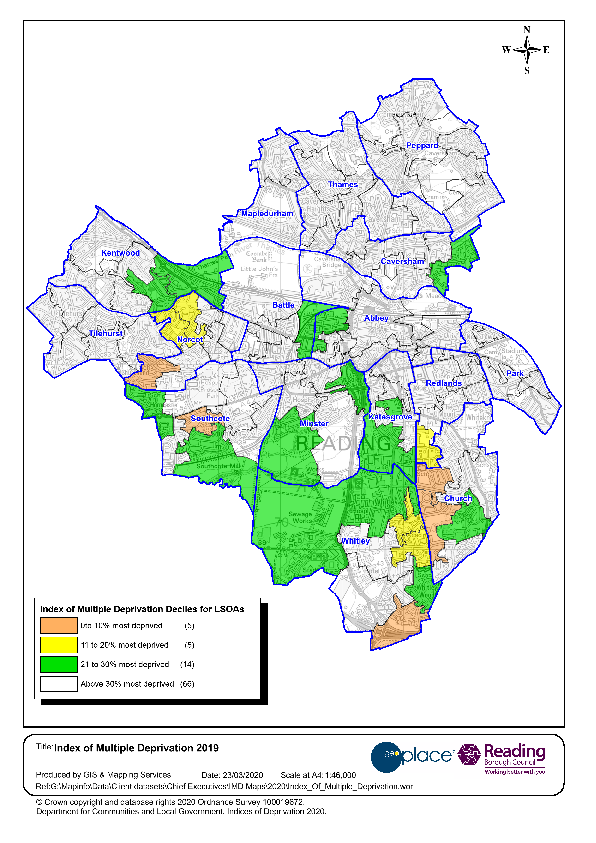
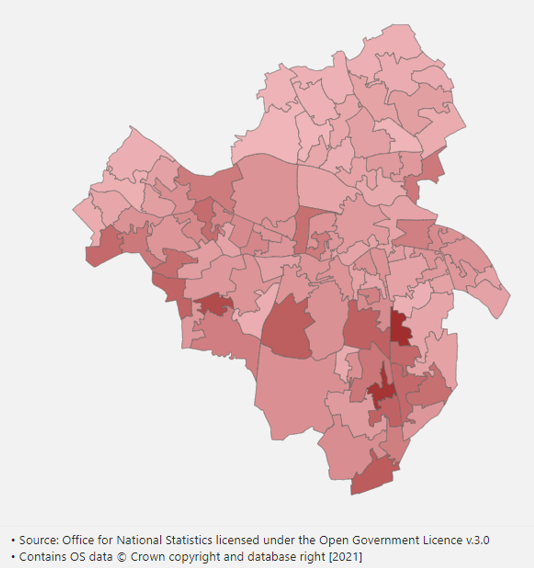
Health
In general terms, Reading tends to score better than the national average for most health measures, although this hides problems amongst particular communities.
- Life expectancy is 6.8 years lower for men and 7.8 years lower for women in the most deprived areas of Reading than in the least deprived areas (Public Health England 2018-20)
- For further information on health see Reading’s Joint Strategic Needs Assessment (JSNA) for Reading
| Location | Proportion of population reporting good or very good health | Proportion of population reporting limiting long-term illness |
|---|---|---|
| Reading 2021 | 85.6% | 13.8% |
| England 2021 | 82.2% | 17.3% |
| Reading 2011 | 85.5% | 13% |
Source: 2021 Census, Office for National Statistics
Crime
Crime and the fear of crime have become more significant issues as Reading’s evening economy has grown over recent years. However, Reading has a fairly average crime rate, when compared our most similar group of Community Safety Partnerships.
- 19,303 crimes were reported in 2023/24, or 102.3 crimes per 1000 population, a 9.7% decrease on the previous year, and the highest rate in the Thames Valley (ONS 2023/24)
- Violent crime has decreased by 4% since the previous year to 36 crimes per 1000 population, joint second highest in the Thames Valley
- Theft offences are38.9% 40 crimes per 1000 population, a slight decrease since the previous year, and the second highest in the Thames Valley
Transport and travel to work
Reading is a major population and employment centre within the South East, benefiting from close proximity to London and Heathrow, and with excellent links to national road and rail networks as well as to Heathrow Airport. Such connectivity is represented by Reading’s status as a regional transport hub and international gateway.
Reading is a major centre of employment, with more jobs than workers, which means there is a significant demand for travelling into Reading from other areas. Reading experiences congestion on many of its main routes during the week, with the commercial success of the town adding to weekend congestion.
- Reading is the 9th busiest station outside London, catering for 17 million passengers a year, with a further 4 million interchanging passengers (Local Transport Plan 2036).
- Despite having the third highest bus use in the country Reading remains one of the most congested towns in the UK, with car congestion in the area, causing the second highest levels of delays in any local authority outside London (it is difficult to compare this variable with 2011 Census because Census 2021 took place during a national lockdown.
| Travel to work and car ownership | Reading 2021 | Reading 2011 | England 2021 |
|---|---|---|---|
| Travel to work by car or van | 31.4% | n/a | 44.5% |
| Travel to work on foot/ by cycle | 11.4% | n/a | 7.6% |
| Number of households with no car | 28.4% | 28.3% | 23.5% |
Source: 2021 Census, Office for National Statistics